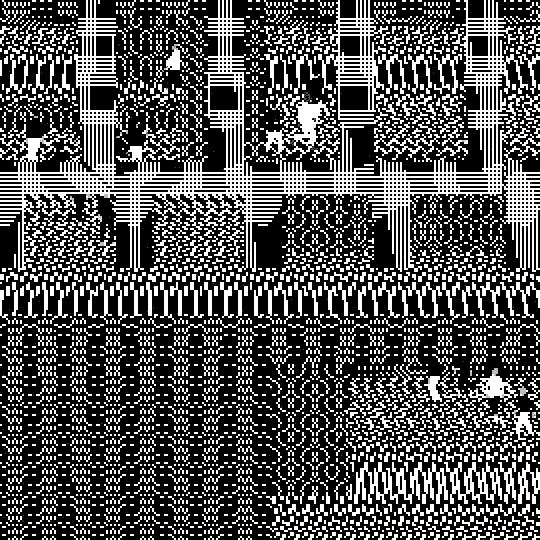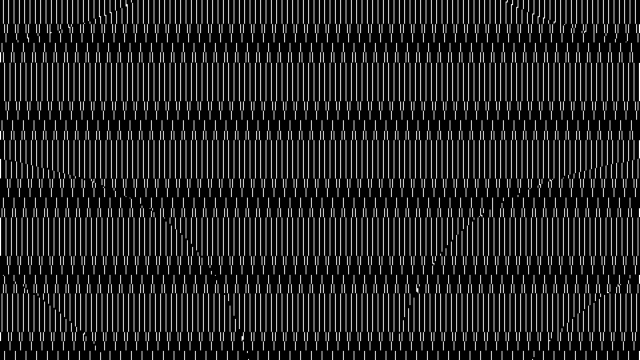
From the Peter Burr exhibition Pattern Language
It’s hard work to build a world. I went to visit Peter Burr in advance of his upcoming exhibition at 3-Legged Dog Art & Technology Center this Sunday to find out just how hard. It’s hot as hell inside the center. At the time of my visit, it resembled a dark dungeon spot lit with computer screens used by Burr and programmer Mark Fingerhut. It takes me less than five minutes to drink the water I was offered.
The space is located in the financial district, an a-typical setting for most working artists, who are more commonly seen showing in the Lower East Side or Bushwick. But Burr is not a typical artist. His work requires a huge amount of development time and technology, as evidenced by six week’s he’s spent holed up there, and a line of work desks, which are a maze of wires, speakers, screens and coffee mugs.
The piece I’m looking at—Pattern Language—blankets the space with light. Four enormous screens form a dog-legged wall, turning what would normally be a square theatre into a long corridor. A dizzying array of black and white images run over the screen while a mix of arpeggiated and drone music play overhead. In one sequence a megaplex modeled as though it were in an roided-out arcade game hosts a never ending stream of people. In another, fractured horizontal stripes furiously move up and down as though blinking. In yet another, the screen turns into a bright white strobe light.

From the Peter Burr exhibition Pattern Language
The scenes move so seamlessly from one pattern to the next that I found myself immediately comparing the work to Koyaanisqatsi, a 1982 film without dialogue or vocalized narrative by Director Godfrey Regiio and Musician Philip Glass. Burr confirmed the reference. “It’s about systems and landscapes and Koyaanisqatsi is about that as well.” He told me. “There are no main actors. It’s about the body of the masses. You get these scenes of individual people, but the camera’s not confronting them. It’s passive.” Pattern Language works in exactly the same way.
Perhaps more accurately described, though, the piece is musically and psychologically structured like a fugue—a contrapuntal composition in which a short melody or phrase is introduced by one part and successively taken up both others. Burr talks about this and Christopher Alexander, whose book Pattern Language inspired the show’s title. The book serves as an index or rule set for building communities, offering more than 250 different chapter headings. In Burr’s case, he’s chosen five phases that can be infinitely rearranged: the arcology blueprint, pattern rhythms, intimacy gradient (humans at play), game of life, and strobe. A program by Fingerhut calls clips from each phase. Visually, they tend to match the title of the phase they’re in.

From the Peter Burr exhibition Pattern Language
Given the structure outlined above, you’d think the Pattern Language was an entirely abstract work of art. It’s not. The piece is an off shoot or study for a larger game in development with the writer and game designer Porpentine called Aria End. (Aria End is currently funded by a $50,000 Creative Capital grant.) “Our game exists in this failed utopia, this megastructure where 1,000,000 people lived.” Burr told me. “Within that game, you play as a woman who is a custodian of this abandoned dirtscraper, this subterranean utopia that’s been abandoned because of an event called The Mess. I was really interested in stepping out of this blanket dystopia and to think more holistically about what it’s like to build a utopia.”
It’s not exactly a utopia, though. Paolo Soleri, an architect famous for his megastructures, is their other inspiration and his work often represents hell for people. Unsurprisingly, the score for the piece is often fairly ominous and the text by Porpentine, which frames the work, describes an unsettling world in which opinions don’t exist, sewers are designed with the “care and cleanliness of optic fibers” and the sun never shines.
That’s just the text on black screens, which focuses on infrastructure. On white, she describes what it feels like to live in the space. That can’t be summed up neatly, but it communicates the experience of living underground in a wholly contained environment. “It’s the idea of constrained people,” Burr tells me. “We wanted to show their presence to create a comfortability with what the future might hold.” Having spent some time with the piece, I couldn’t help but chuckle at this a bit at this. I wasn’t at all comfortable. But Burr acknowledges this as well, adding, “There’s something a bit more dissonant with it too. That’s where the strobing comes in.”


Comments on this entry are closed.